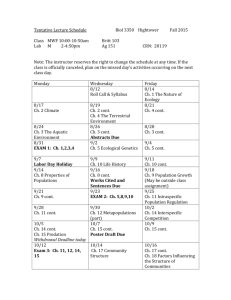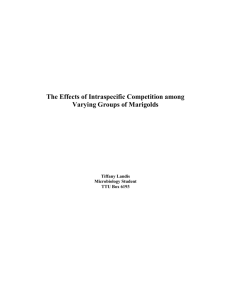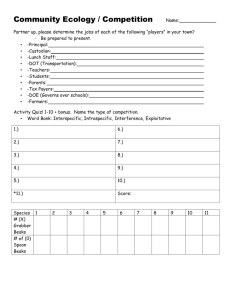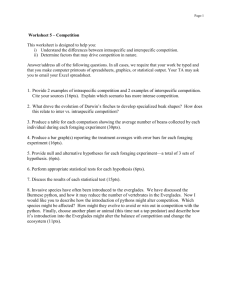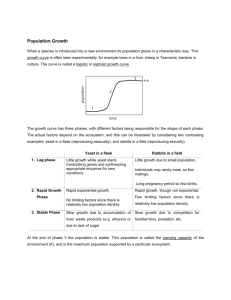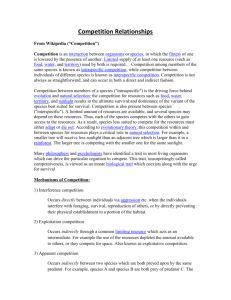The Effects of Intraspecific Competition among Varying Groups of
advertisement
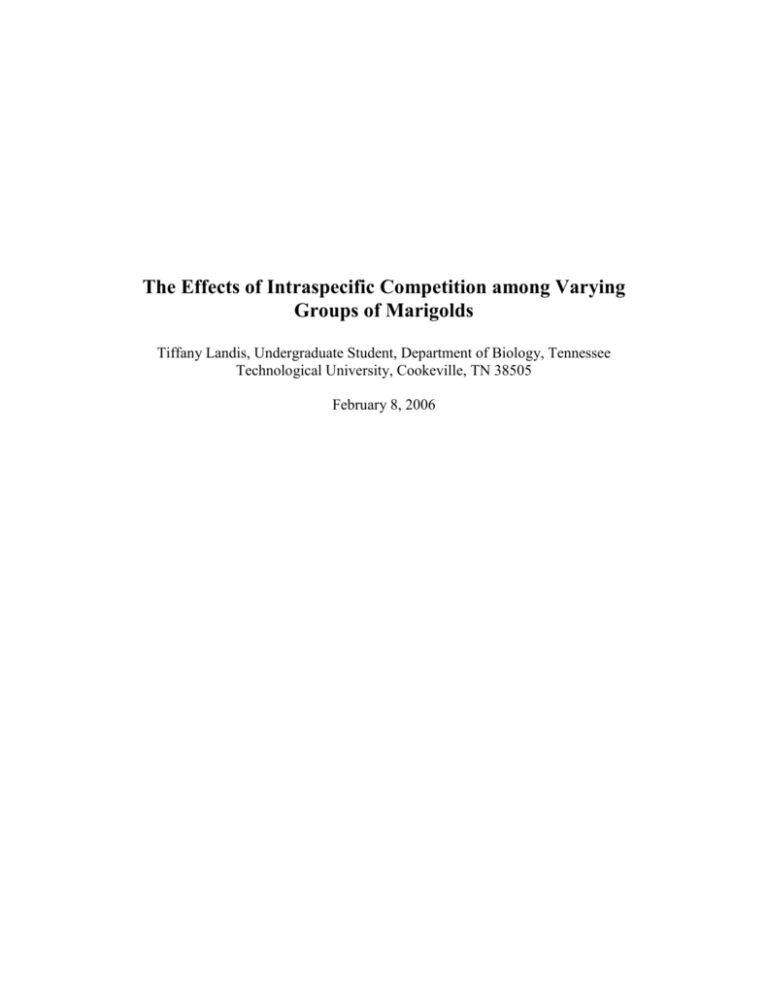
The Effects of Intraspecific Competition among Varying Groups of Marigolds Tiffany Landis, Undergraduate Student, Department of Biology, Tennessee Technological University, Cookeville, TN 38505 February 8, 2006 2 Table of Contents Project Summary Introduction Methods and Material Expected Results and Benefits Project Timeline Literature Cited Budget Project Summary Problem: Does intraspecific competition affect the alyssums vitality? 3 Objective/ Hypothesis: To determine if Intraspecific competition affects plant growth. Intraspecific competition foes affect density and growth of Marigold plants. How I plan to accomplish my goal: Planting varying densities of Marigolds to determine if intraspecfic competition affects their growth. Expected benefits and Results: This should be beneficial to farmers and gardeners who will then know that you cannot plant a bunch of plants together or they will compete each other and eventually one will out compete the other and cause plants to be either stunted in growth or just die. Introduction Competition for resources is what drives natural selection. As Darwin stated 4 “Only the fit survive.” Those species that are best suited for survival are the ones that can out compete with other species for the same-shared resources. There are two forms of competition interspecific competition and intraspecific competition. Interspecific competition occurs when two or more species compete for some limited resource. When one species is a better competitor in this case they negatively effect the other species, this can cause the population of the other species to decline in population size. Intraspecific competition occurs between members of the same species. They will both compete for the same limited resource. A consequence of intraspecific competition would be that when the population becomes more dense the survival and/or reproduction rates of the individuals declines. “Competition, either among members of the same or different species may have broad effects on plant community structure. The more crowded a population the more competition there is for resources.” (Tansley, 1917) In many cases intraspecific competition will occur because of the need to compete for the same shared resource, such as the need for space. “Spatial arrangement of plants in a community can be an important determinant of species coexistence and biodiversity” (Stoll et al, 2001). In this study plants were grown in two densities either randomly or intraspecifically aggregated. Stoll and his colleague Prati concluded that the Competitively superior species had a lower biomass in the aggregated distribution than in the random distribution at high densities. “The data supported the hypothesis that the spatial distribution of plants profoundly affects competition in such a way that weaker competitors increase their fitness while stronger competitors are suppressed when grown in the neighborhood of co specifics” (Stoll et al, 2001). One of the central questions in ecology is how important is competition among 5 individuals within species (intraspecific) in determining the fitness of individuals in populations. One way to address this question is to grow organisms in single species groups in the laboratory. Plants that lack the proper nutrients will not have what it takes to survive. Day and her colleagues found that when plants are nutrient poor soil they would be smaller compared to plants in nutrient rich soils. They also found that mortality was higher in nutrient rich soils then in nutrient poor soil. Thus, one can conclude from their findings those plants will be of greater in abundance in nutrient rich soils and more susceptible to competition, which those plants in the nutrient poor soil will not have to compete because the nutrients are already limited. In my experiment with Alyssum I looked to intraspecific competition to determine if plants with more competitors will end up smaller than plants grown with fewer competitors. The idea being that competitors will take up light and nutrients and leave a lot less of those nutrients for other plants. My null hypothesis being that no matter the density, plant weight and height will reflect no difference among the varying densities. As one species competes, the other must also in order to survive. I knew that the most fit will survive and through the experiment I conducted I will try to provided evidence to support my hypotheses. Methods and Materials I obtained six pots and labeled them according to the number of seeds in each 6 pot. The pots were also labeled with our group name to make sure there was not any confusion as to whose plants to belong to whom. The plants were kept in a sunroom and watered regularly. Each of the six pots was filled with soil until it came to about one centimeter from the top of the pot. I obtained Marigold seeds and planted the following densities of seeds in each pot: 3, 5, 10, 18, 34, or 68 seeds. After germination, the plant populations were thinned to 2, 4, 8, 16, 32, or 64 plants per pot. When then placed more soil on top of the seeds and watered them. Each week we measured the number of leaves on each plant in each pot, heights of the plant stems, and number of flowers on each plant. We then gathered detailed information from each pot number of plants, weights of plant stems, number of leaves and length of stems. We obtained stem weights of the plants by clipping out the plants at soil level, clipping off the leaves and placing them on a scale. Expected Results and Benefits I expect that intraspecific competition will affect the growth of plants and that they will 7 Compete with each other for the same shared resource. This should be beneficial to farmers and gardeners who will then know that you cannot plant a bunch of plants together or they will compete each other and eventually one will out compete the other and cause plants to be either stunted in growth or just die. 8 Project Timeline Planted seeds and watered them Watered plants and took measurements Watered Plants and took measurements Week 1 Week 3 Week 5 Week 2 Week 4 Week 6 Watered plants and took measurements Watered plants and took measurements End of Projectcollected measurements 9 Literature Cited Aguiar, M.R., Lauenroth, W.K. and Peters, D.P. 2001. Intensity of intra- and interspecific competition in coexisting shortgrass species. Journal of Ecology 89: p.40. Day K. J., Hutchings M.J. and John, E.A. 2003. The effects of spatial pattern of nutrient supply on yield, structure and mortality in plant populations. Journal of Ecology 91: pp.541-553 Siemens, D.H., Garner, S.H.; Mitchell-Olds, T. and Callaway, R.M. 2002. Cost of defense in the context of plant competition: Brassica rapa may grow and defend. Ecology 83: pp 505-518. Stoll, P. and Prati, D. 2001. Intraspecific Aggregation Alters Competitive Interactions In Experimental Plant Communities Ecology 82: p319. Tansley, AG. 1917. On competition between Gallium saxatile L. and Gallium sylvestre pll. on different types of soil. J. Ecology. 5:173-179. 10 Budget Budget Potting Soil Marigold Seeds Balance 6 Flower Pots $2.50 $2.00 $31.00 $24.00 11 12 13 14
